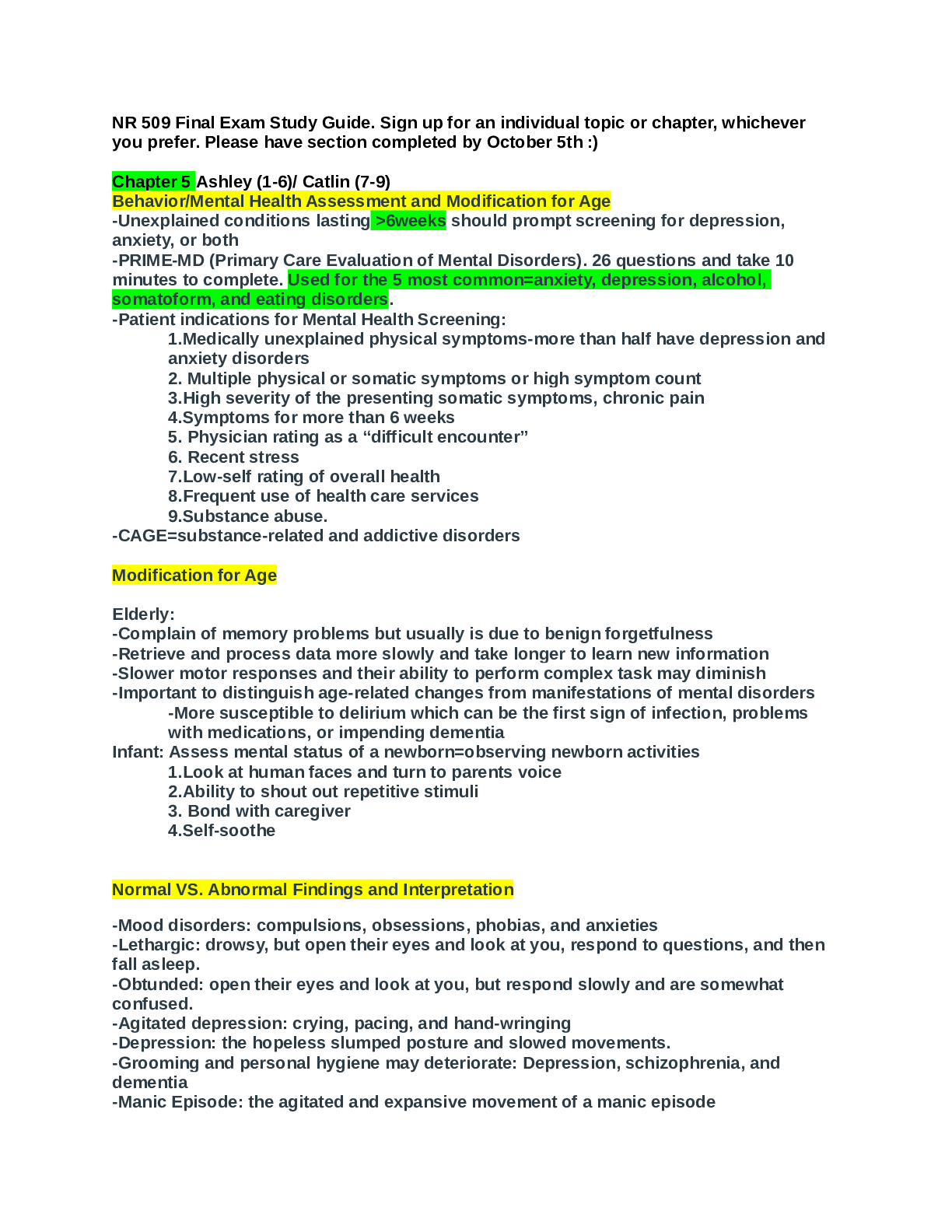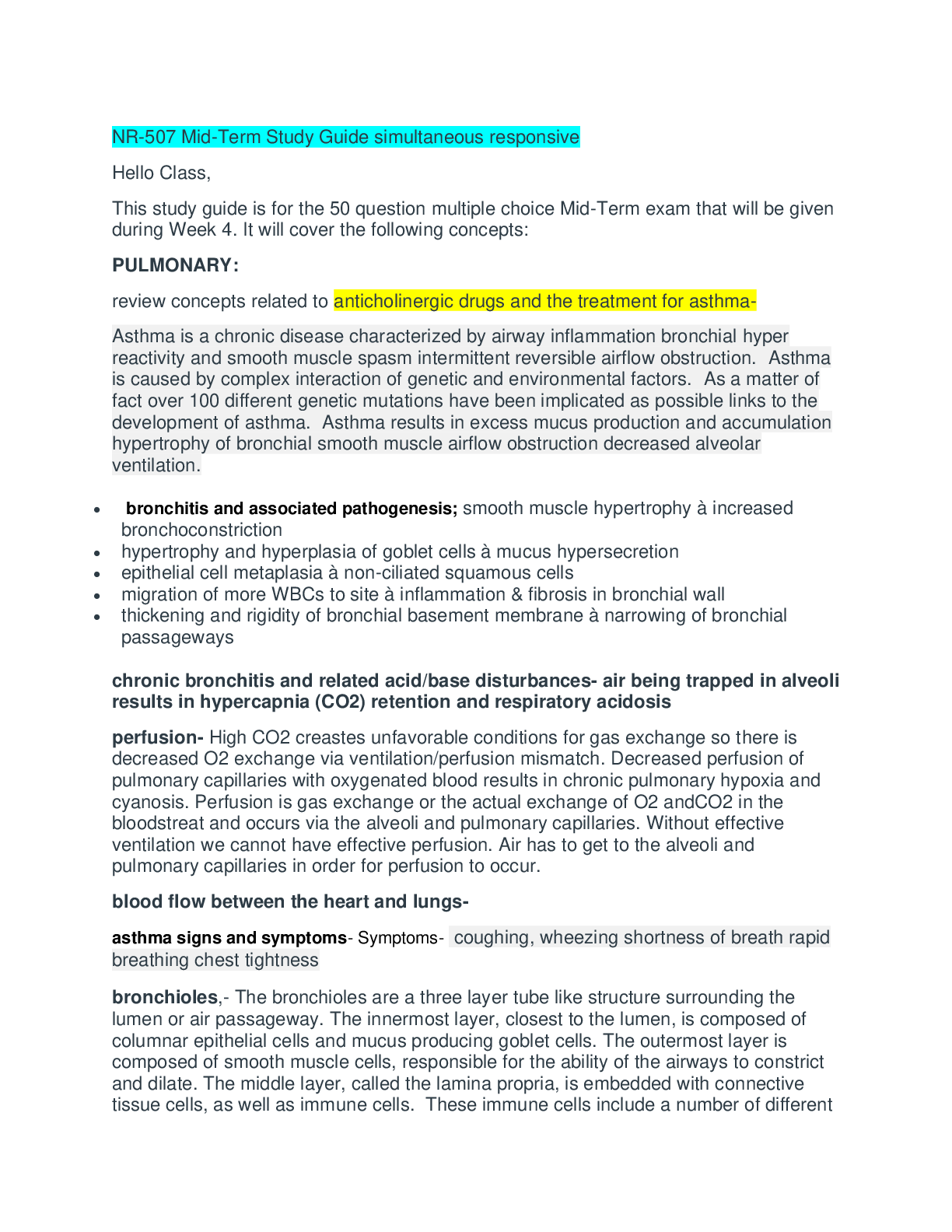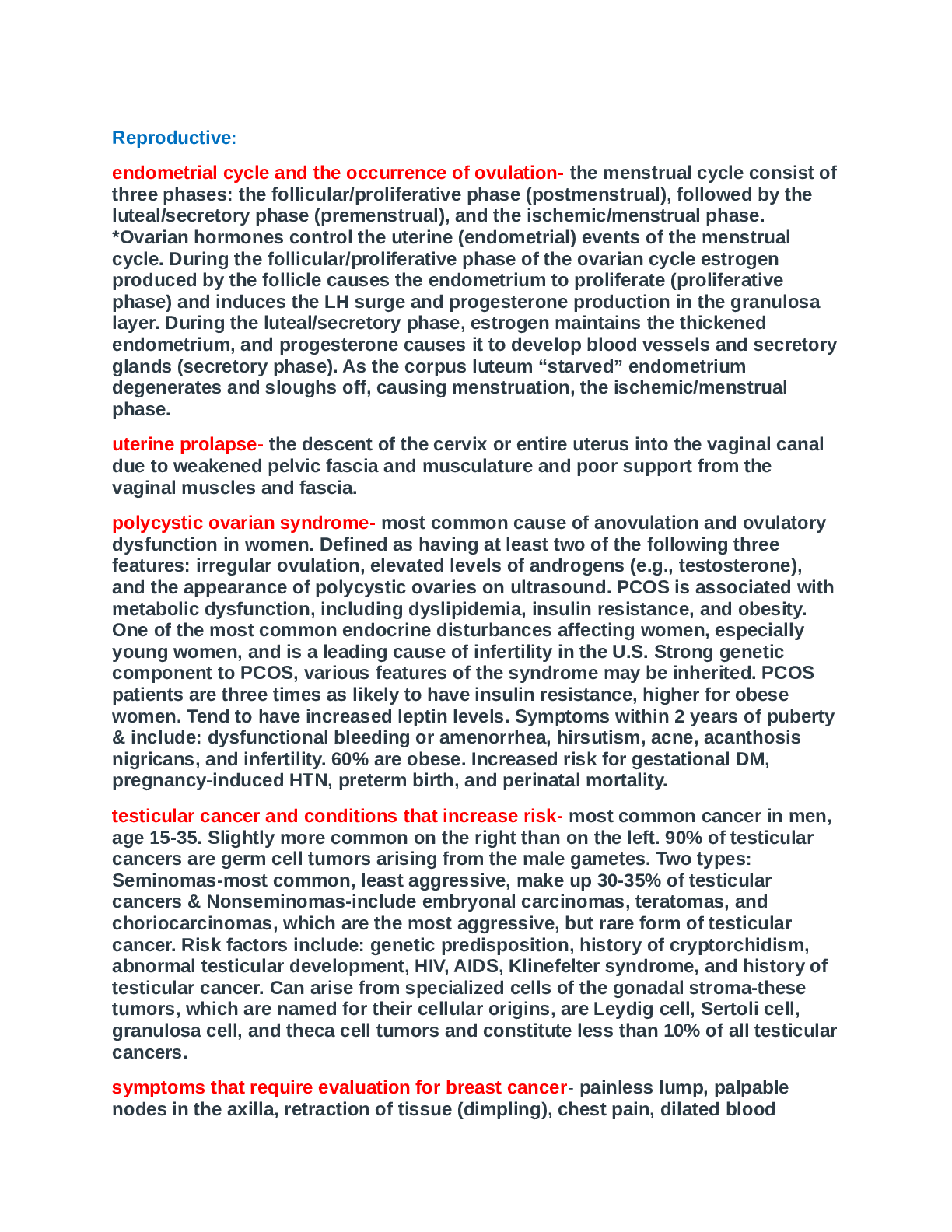*NURSING > STUDY GUIDE > NRSG 2510: Exam 4 (original reading list) Addictive Behaviors, Violence Behaviors, Cognition, & Peri (All)
NRSG 2510: Exam 4 (original reading list) Addictive Behaviors, Violence Behaviors, Cognition, & Perioperative Care (ASSURED A)
Document Content and Description Below
NRSG 2510: Exam 4 (original reading list) Addictive Behaviors, Violence Behaviors, Cognition, & Perioperative Care (ASSURED A) Chapter 11: Substance Abuse MULTIPLE CHOICE 1. Which assessment findin... g would alert the nurse to ask the patient about alcohol use? a. Low blood pressure b. Decreased heart rate c. Elevated temperature d. Abdominal tenderness ANS: D Abdominal pain associated with gastrointestinal tract and liver dysfunction is common in patients with chronic alcohol use. The other problems are not associated with alcohol abuse. DIF: Cognitive Level: Apply (application) REF: 160 TOP: Nursing Process: Assessment MSC: NCLEX: Psychosocial Integrity 2. The nurse plans postoperative care for a patient who smokes a pack of cigarettes daily. Which goal should the nurse include in the plan of care for this patient? a. Improve sleep b. Enhance appetite c. Decrease diarrhea d. Prevent sore throat ANS: A Insomnia is a characteristic of nicotine withdrawal. Diarrhea, sore throat, and anorexia are not symptoms associated with nicotine withdrawal. DIF: Cognitive Level: Apply (application) REF: 156 TOP: Nursing Process: Planning MSC: NCLEX: Psychosocial Integrity 3. A young adult patient scheduled for an annual physical examination arrives in the clinic smelling of cigarette smoke and carrying a pack of cigarettes. Which action will the nurse plan to take? a. Urge the patient to quit smoking as soon as possible. 2 b. Avoid confronting the patient about smoking at this time. c. Wait for the patient to start the discussion about quitting smoking. d. Explain that the “cold turkey” method is most effective in stopping smoking. ANS: A Current national guidelines indicate that health care professionals should urge patients who smoke to quit smoking at every encounter. The other actions will not help decrease the patient’s health risks related to smoking. DIF: Cognitive Level: Apply (application) REF: 156 TOP: Nursing Process: Planning MSC: NCLEX: Health Promotion and Maintenance 4. A patient admitted to the hospital after an automobile accident is alert and does not appear to be highly intoxicated. The blood alcohol concentration (BAC) is 110 mg/dL (0.11 mg%). Which action by the nurse is mostappropriate? a. Avoid the use of IV fluids. b. Maintain the patient on NPO status. c. Administer acetaminophen for headache. d. Monitor frequently for anxiety, hyperreflexia, and sweating. ANS: D The patient’s assessment data indicate probable physiologic dependence on alcohol, and the patient is likely to develop acute withdrawal such as anxiety, hyperreflexia, and sweating, which could be life threatening. Acetaminophen is not recommended because it is metabolized by the liver. IV thiamine and IV glucose solutions usually are given to intoxicated patients to prevent Wernicke’s encephalopathy, and there is no indication that the patient should be NPO. DIF: Cognitive Level: Apply (application) REF: 160-161 TOP: Nursing Process: Implementation MSC: NCLEX: Psychosocial Integrity 5. An alcohol-intoxicated patient with a penetrating wound to the abdomen is undergoing emergency surgery. What will the nurse expect the patient to need during the perioperative period? a. An increased dose of the general anesthetic medication b. Frequent monitoring for bleeding and respiratory complications c. Interventions to prevent withdrawal symptoms within a few hours d. Stimulation every hour to prevent prolonged postoperative sedation ANS: B Patients who are intoxicated at the time of surgery are at increased risk for problems with bleeding and respiratory complications such as aspiration. In an intoxicated patient, a lower dose of anesthesia is used because of the synergistic effect of the alcohol. 3 Withdrawal is likely to occur later in the postoperative course because the medications used for anesthesia, sedation, and pain will delay withdrawal symptoms. The patient should be monitored frequently for oversedation but does not need to be stimulated. DIF: Cognitive Level: Apply (application) REF: 155 TOP: Nursing Process: Planning MSC: NCLEX: Psychosocial Integrity 6. A patient with alcohol dependence is admitted to the hospital with back pain following a fall. Twenty-four hours after admission, the patient becomes tremulous and anxious. Which action by the nurse is most appropriate? a. Insert an IV line and infuse fluids. b. Promote oral intake to 3000 mL/day. c. Provide a quiet, well-lit environment. d. Administer opioids to provide sedation. ANS: C The patient’s symptoms suggest acute alcohol withdrawal, and a quiet and well-lit environment will help decrease agitation, delusions, and hallucinations. There is no indication that the patient is dehydrated. Benzodiazepines, rather than opioids, are used to prevent withdrawal. IV lines are avoided whenever possible. DIF: Cognitive Level: Apply (application) REF: 162 TOP: Nursing Process: Implementation MSC: NCLEX: Psychosocial Integrity 7. A patient with a history of heavy alcohol use is diagnosed with acute gastritis. Which statement by the patient indicates a willingness to stop alcohol use? a. “I am older and wiser now, and I think I can change my drinking behavior.” b. “Alcohol has never bothered my stomach before. I think I likely have the flu.” c. “My drinking is affecting my stomach, but some drugs will help me feel better.” d. “People say that I drink too much, but I really feel pretty good most of the time.” ANS: A The statement “I am older and wiser now, and I know I can change my drinking behavior” indicates the patient expresses willingness to stop alcohol use and an initial commitment to changing alcohol intake behaviors. In the remaining statements, the patient recognizes that alcohol use is the reason for the gastritis but is not yet willing to make a change. DIF: Cognitive Level: Apply (application) REF: 156 TOP: Nursing Process: Assessment MSC: NCLEX: Psychosocial Integrity 8. A patient who smokes a pack of cigarettes daily develops tachycardia and irritability on the second day after abdominal surgery. What is the nurse’s best action at this time? 4 a. Escort the patient outside where smoking is allowed. b. Move the patient to a private room and allow smoking. c. Tell the patient that this is a good time to quit smoking. d. Request a prescription for a nicotine replacement agent. ANS: D Nicotine replacement agents should be prescribed for patients who smoke and are hospitalized to avoid withdrawal symptoms. Allowing the patient to smoke encourages ongoing smoking. Urging the patient to quit smoking is appropriate, but the first action should be to obtain appropriate medications to prevent withdrawal symptoms. DIF: Cognitive Level: Apply (application) REF: 156-157 TOP: Nursing Process: Implementation MSC: NCLEX: Psychosocial Integrity 9. A patient who is admitted to the hospital for wound debridement admits to using fentanyl (Sublimaze) illegally. What finding does the nurse expect? a. Nausea and diarrhea b. Tremors and seizures c. Lethargy and disorientation d. Delusions and hallucinations ANS: A Symptoms of opioid withdrawal include gastrointestinal symptoms such as nausea, vomiting, and diarrhea. The other symptoms are seen during withdrawal from other substances such as alcohol, sedative-hypnotics, or stimulants. DIF: Cognitive Level: Understand (comprehension) REF: 163 TOP: Nursing Process: Assessment MSC: NCLEX: Psychosocial Integrity 10. A newly admitted patient complains of waking frequently during the night. The nurse observes the patient wearing a nicotine patch (Nicoderm CQ) on the right upper arm. Which action is best for the nurse to take? a. Question the patient about use of the patch at night. b. Suggest that the patient go to bed earlier in the evening. c. Ask the health care provider about prescribing a sedative drug for nighttime use. d. Remind the patient that the benefits of the patch outweigh the short-term insomnia. ANS: A 5 Insomnia can occur when nicotine patches are used all night. This can be resolved by removing the patch in the evening. The other actions may be helpful in improving the patient’s sleep, but the initial action should be to ask about nighttime use of the patch and suggest removal of the patch at bedtime. DIF: Cognitive Level: Apply (application) REF: 159 TOP: Nursing Process: Assessment MSC: NCLEX: Psychosocial Integrity 11. During physical assessment of a patient who has frequent nosebleeds, the nurse finds nasal sores and necrosis of the nasal septum. The nurse should ask the patient specifically about the use of which drug? a. Heroin b. Cocaine c. Tobacco d. Marijuana ANS: B When cocaine is inhaled, it causes ischemia of the nasal septum, leading to nasal sores and necrosis. These symptoms are not associated with the use of heroin, tobacco, or marijuana. DIF: Cognitive Level: Apply (application) REF: 155 TOP: Nursing Process: Assessment MSC: NCLEX: Psychosocial Integrity [Show More]
Last updated: 2 years ago
Preview 1 out of 201 pages

Buy this document to get the full access instantly
Instant Download Access after purchase
Buy NowInstant download
We Accept:

Reviews( 0 )
$12.50
Can't find what you want? Try our AI powered Search
Document information
Connected school, study & course
About the document
Uploaded On
Aug 01, 2021
Number of pages
201
Written in
Additional information
This document has been written for:
Uploaded
Aug 01, 2021
Downloads
0
Views
49

.png)












